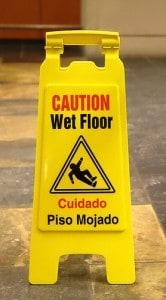One of the decisions you’ll have to make when handling a chemical spill in the workplace is whether to contain or absorb it. Some products are designed strictly for containing liquids, whereas others actually absorb liquids. Being that each and every situation is different, there’s no universal “right” way to handle a chemical spill. With that said, there are some general tips that can help you decide which course of action is right for your chemical spill.
The first step in handling a workplace spill is to identify the chemical. Attempting to contain and/or absorb an unknown agent is both careless and dangerous. If the liquid is highly corrosive and comes into contact with your skin — or if you inhale it — it could result in serious injury. Before you even think of attempting to contain a spill, identify the type of chemical. This will give you a better understanding of its properties and how to protect yourself from injury.
Spills involving non-invasive water-based liquids are easily cleaned using absorbent socks, pillows and wipes. Rather than worrying about containing the liquid, go ahead and work to absorb it using the previously mentioned products. Placing several corn cob universal absorbent socks directly into the “heart” of a water-based spill will instantly soak it up. And when the absorbent socks have worked their magic, you can simply toss them in the trash.
Of course, spills involving aggressive chemicals require a more cautious and methodical approach. If the chemical is deemed “hazardous,” only a qualified worker with knowledge and training experience of the chemical should handle it. The first course of action involving spills of aggressive chemicals in the workplace is to contain them so they don’t spread to other areas. Berms offer a fast and effective way to contain aggressive chemicals without placing the well-being of workers in jeopardy. Containment booms can also be used to contain chemicals to a particular area.
Spill response varies depending on the type of chemical/liquid spilled and the surrounding environment. However, it’s important to note that workers should always gear up in the appropriate personal protective equipment (PPE) before handling any spilled chemicals. The employer is responsible for providing this equipment based on OSHA’s specifications. When the worker is geared up, he or she can then decide whether to contain or absorb the spilled liquid.
